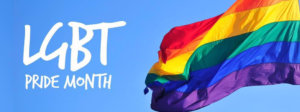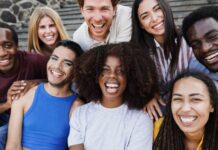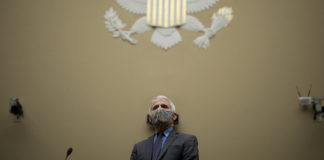By Melodee Mabbitt
This year, Flint’s Pride Festival will once again be shaped in response to the need for disease prevention and centered on supporting identities that are most vulnerable within Flint’s LGBTQ+ communities.
In response to COVID-19 precautions, planning is underway for Flint’s Pride to include its annual barbecue and a series of small events throughout the coming summer, rather than the annual festival in June.
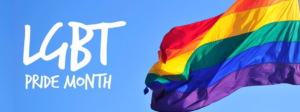
(Photo source: www.wellnessaids.org)
It won’t be the first time Flint’s Pride celebrations have been affected by disease. Flint’s tenth annual Pride Festival was held as a virtual event last year because of the pandemic. And the event’s history is itself rooted in disease prevention and centered on identities within vulnerable populations.
“We’re not just regular event planners. We’re disease prevention,” said Stevi Atkins, CEO of Wellness AIDS Services, which has been central to organizing Flint’s Pride celebrations.
“All of the communities we serve are at greater risk of death or harm because of the lack of cultural competence,” Atkins said. “All of our local health disparities are around racism. That’s it. Racism, homophobia, Islamophobia, and especially transphobia. Our Black trans women are still being murdered at rates that are unconscionable to allow.”
“We have had white gay men from outside of our community come give us feedback and basically imply that our event is too Black,” Atkins said. “It has been a challenge to help the community understand that Flint is over 60 percent BIPOC [black, indigenous, and people of color] and our event needs to at least reflect that.”

Wellness Clinic logo (Photo source: wellnessaids.org)
Atkins said Flint Pride was developed partly in response to an outbreak of HIV in 2009 in Black men ages 17 to 37, especially those who identify as queer, gay, or bi. To reach vulnerable populations, HIV organizations had to be flexible over the years, offering services and testing at gay bars, parks, and other places that you wouldn’t typically find healthcare. Wellness has followed that approach, she said, but by 2009 Flint had fewer gay bars or public spaces for LGBTQ+ gatherings and there was a need to get creative.
“At the time in Flint, there was no LGBTQ+ visibility at all,” Atkins said. In 2009, RuPaul’s Drag Race television series was just beginning and FX network’s series Pose had not yet appeared to bring “ball culture” into the mainstream. Ball culture developed as an underground subculture of Black and Latinx LGBTQ+ youth in New York City, in which people “walk” for trophies, prizes, and glory at events known as balls.
In Flint’s Black LGBTQ+ communities, ball houses serve as alternative families to Black LGBTQ+ youth who often compete in drag performances and ball walking competitions to earn needed income by winning a pageant or category.
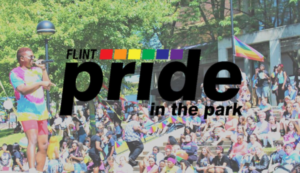
Pride in the Park photo from past years. (Photo source wellnessaids.org)
Making forays into these ball houses was necessary for Wellness AIDS Services to be able to connect in 2009 with the communities being most impacted by the local HIV outbreak, Atkins explained. As they began to build relationships, especially with Black ball house fathers, it became clear that something more was needed.
”It is hard to see yourself in progress, in history, if you don’t know that people who look like you were there,” Atkins said. “It was actually trans women of color pushing back at Stonewall. That is important to know in order to be able to see yourself in history.”
The Stonewall uprising was a series of spontaneous demonstrations in response to a police raid at the Stonewall Inn in New York City in 1969, and is widely considered one of the most important events leading to the fight for LGBTQ+ rights.
Wellness organized Flint’s first Pride Festival in 2010 not only to help raise visibility of LGBTQ+ communities, but to build relationships external to small social groups by connecting LGBTQ+ communities and sharing feelings of being cared for and valued in a larger set of communities, and to celebrate the history of Black trans women as central in this work.

(Photo source: www.wellnessaids.org)
Flint’s first Pride Festival was a small event in Kearsley Park with about 150 attendees, one food vendor, one sponsor, two tables set up by PFLAG and Wellness AIDS Services, and of course, drag performances.
“We started having mini-balls at our first Pride event,” Atkins said, noting that Wellness was able to obtain their first physical location in 1986 because of local drag performers who donated their tips to buy the space. “It felt very community and the population we hoped to reach was who showed up,” she said.
In the following years, Flint’s Pride Festival grew through a partnership with Tendaji Ganges, the former executive director of Educational Opportunity Initiatives at the University of Michigan – Flint, and moved to the university’s pavilion on Saginaw Street downtown.
Pride has continued to have balls, drag performances, and voguing competitions every year. “Having the space for local drag kings and queens is really important to us,” Atkins said.
Flint’s Pride Festival has always been a smaller and more intimate affair than Pride festivals in larger cities, she said. In places like New York and Chicago, complaints among activists include concerns about Pride becoming too “corporate” as sponsors want their brands to seem supportive without making any sincere forays into LGBTQ+ communities, Atkins said.
That is not true in Flint. Though attendance and the need for porta-potties has grown, Atkins said obtaining sponsorships continues to be a struggle, largely funded by Blue Cross Blue Shield of Michigan and Wellness’s own general fund. However, Atkins believes the event sponsors are reflective of sincere supporters from within Flint’s community.
At the last in-person festival in 2019, Pride had grown from the university’s pavilion, across Saginaw Street, and into Riverbank Park. More than three thousand people attended the event, which included more than 60 vendors, ranging from religious organizations to artists to community organizations.
To be inclusive, organizers emphasize creating spaces for artists to sell their work and keeping vendor fees low by having five dollar spots and allowing nonprofits or people unable to pay to approach Wellness to find a way to be included.
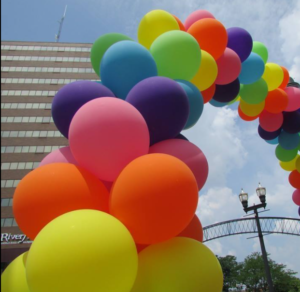
Pride Fest 2019 downtown Flint. (Photo source: Flint Pride Fest Facebook page)
Progress on LGBTQ+ issues locally has also contributed to the steady growth of the Pride Festival in Flint.
“Through the years, we have always had something to celebrate,” said Atkins noting national marriage equality passing in the U.S. Supreme Court in 2015, the passing of Flint’s local human rights ordinance around housing and accommodation in 2012, which Wellness worked with local activists Tunde Olinaran, Dale Weighill, and Nayyirah Shariff to spearhead and pass. Last year, Mayor Sheldon Neeley officially declared June as Pride Month in Flint.
“Every year it felt like more and more progress until the orange man,” said Atkins in reference to reality television gameshow host and former one-term president Donald Trump. “Really in Michigan, we started to slip backwards before Trump. Governor Rick Snyder had a lot of anti-LGBTQ+ language and legislation during his time.”
Though Flint’s Pride has never experienced violence or protests from opposition, there have been hard years like the Orlando Pulse shooting in 2016 when Pride created space for grieving and acknowledging that terrorist attack at a gay nightclub. “Kildee offered a great speech on it that year,” Atkins said, noting Kildee has been one of the most supportive elected officials.
Atkins says she looks forward to one day running the front table again at Pride in-person. It is one of her favorite things to do.
“The energy, the vibration, the love. This is what community care looks like. Being able to show our LGBTQ+ population, especially with the intersection of BIPOC, that we care about them is huge for us,” Atkins said. “Being able to hug them and to embrace each other and get excited when someone is attending their first Pride. It is just an amazing energy and I love that role of being a hostess to welcome my community into my community.”
When Flint began organizing the first Pride Festival, Nayyirah Shariff was working as an organizer for Genesee County Healthy Sexuality Coalition, a group of organizations and individuals interested in lowering rates of teen pregnancy and sexually transmitted diseases. Though that coalition no longer exists, Shariff continued to be involved through volunteering in the years since.
“For a lot of people, Pride is where you get to wear rainbow wigs and heavy makeup and then you’re out there drinking beer. That is what you see in other, larger Prides” Shariff said.
“But then you also see people who bring ‘Yes, I am gay and also these other things.’ So other Prides may censor the most marginalized people are Black and trans women. So by centering those identities and saying Black trans lives matter, or allowing people to be gay and Muslim, it becomes more than just wearing a rainbow wig and allows people to have multiple identities. Like, intentionally making space for people to declare, ‘I’m not just a gay person. I am all of these identities and all of them deserve respect.’”
Flint Pride Festival events this summer will be shared through the Flint Pride Facebook Page.
EVM reporter Melodee Mabbitt can be reached at melodee.mabbitt@gmail.com.

